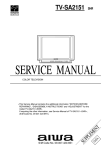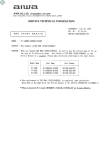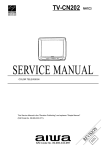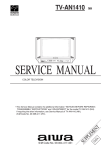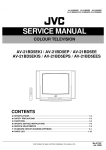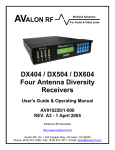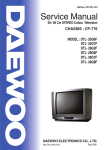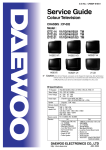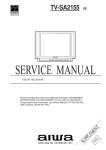Download Aiwa MF-350 Service manual
Transcript
TV-SE2130 TV-SE1430 KY EZY KY EZY SERVICE MANUAL S/M Code No. 09-009-350-0N1 DA TA COLOR TELEVISION NOTICES BEFORE REPAIRING To make the best use of this equipment, make sure to obey the following items when repairing (or mending). 1. Do not damage or melt the tunicate of the leading wire on the AC1 side, including the power supply cord. 2. Do not soil or stain the letters on the spec. inscription plates, notice labels, fuse labels, etc. 3. When repairing the part extracted from the conducted side of the board pattern, fix it firmly with applying bond to the pattern and the part. 4. Restore the following items after repairing. 1) Conditions of soldering of the wires (especially, the distance on the AC1 side). 2) Conditions of wiring, bundling of wires, etc. 3) Types of the wries. 4) Attachment conditions of all types of the insulation. 5. After repairing, always measure the insulation resistance and perform the voltage-withstand test (See Fig-1). 1) The insulation resistance must be 7.3 MΩ to 10.1 MΩ when applying 500V per second. 2) In the voltage withstand test, apply 3.0 kV for 1 minute and check that the GO lamp lights. * * * * Insulation resistance: 7.3MΩ to 10.1 MΩ (500 V/s) Voltage-withstand: 3.0 kV for 1 minute Safety checker (Model 7110, etc.) Earth cable AC cable Connect the earth cable to the outside metal part terminal. Fig-1 Breaking current set to 10 mA. Connect the safety checker as shown in Fig-1, then measure the resistance and perform the test. Do not touch the equipment during testing. For details of the safety checker, refer to the supplied Operation manual. When servicing and checking on the TV, note the followings. 1. Keep the notices As for the places which need special attentions, they are indicated with the labels or seals on the cabinet, chassis and parts. Make sure to keep the indications and notices in the operation manual. 2. Avoid an electric shock. There is a high voltage part inside. Avoid an electric shock while the electric current is flowing. 3. Use the designated parts. The parts in this equipment have the specific characters of incombustibility and withstand voltage for safety. Therefore, the part which is replaced should be used the part which has the same character. Especially as to the important parts for safety which is indicated in the circuit diagram or the table of parts as a ! mark, the designated parts must be used. 4. Put parts and wires in the original position after assembling or wiring. There are parts which use the insulation material such as a tube or tape for safety, or which are assembled so that these parts do not contact with the printed board. The inside wiring is designed not to get closer to the pyrogenic parts and high voltage parts. Therefore, put these parts in the original positions. 5. Take care of the cathode-ray tube. By setting an explosion-proof cathode-ray tube is set in this equipment, safety is secured against implosion. However, when removing it or serving from backward, it is dangerous to give a shock. Take enough care to deal with it. 6. Avoid an X-ray. Safety is secured against an X-ray by considering about the cathode-ray tube and the high voltage peripheral circuit, etc. Therefore, when repairing the high voltage peripheral circuit, use the designated parts and do not change the circuit. Repairing except indicates causes rising of high voltage, and the cathode-ray tube emits an X-ray. 7. Perform a safety check after servicing. Confirm that the screws, parts and wiring which were removed in order to service are put in the original positions, or whether there are the portions which are deteriorated around the places serviced. ! Safety Components Symbol This symbol is given to important parts which serve to maintain the safety of the product, and which are made to confirm to special Safety Specifications. Therefore, when replacing a component with this symbol make absolutely sure that you use a designated part. -2- SPECIFICATIONS Tuner system Picture tube TV system Channel coverage Antenna input Video input Video output Audio input Audio output Operating temperature Power requirements Power consumption Standby Dimensions Weight Frequency synthesized tuner TV-SE2130: 21 in.(50.8 cm “V”), 90 degree deflection TV-SE1430: 14 in.(34 cm “V”), 90 degree deflection PAL (B/G, D/K, I), SECAM (D/K, L) VHF: E2-E12 UHF: E21-E69 CABLE: S1-S41 75 ohms, unbalanced 1.0 Vp-p, 75 ohms, unbalanced 1.0 Vp-p, 75 ohms, unbalanced -3.8 dBs, 50 kohms -3.8 dBs less than 1 kohm 5°C to 40°C 220-240 V AC, 50 Hz TV-SE2130: 74 watts TV-SE1430: 60 watts TV-SE2130: 3 watts TV-SE1430: 3 watts TV-SE2130: 610(W) x 448(H) x 485(D) mm (241/8 x 173/4 x 191/8 in.) TV-SE1430: 450(W) x 332(H) x 377(D) mm (173/4 x 131/8 x 147/8 in.) TV-SE2130: Approx. 22 kg (48.4 lbs.) TV-SE1430: Approx. 11.5 kg (25.3 lbs.) • Design and specifications are subject to change without notice. ACCESSORIES LIST REF. NO 1 1 2 2 PART NO. KANRI NO. 8A-JB4-901-010 8A-JB4-903-010 8A-JB4-610-010 8A-JB4-610-010 DESCRIPTION IB,K (E) -SE2130/ 1430<14KY,21KY> IB,EZ (EGDSI) -SE2130/ 1430<14EZY,21EZY> RC UNIT,RC-AVT02<14KY,14EZY> RC UNIT,RC-AVT02<21KY,21EZY> -3- DISASSEMBLY INSTRUCTIONS 1. REAR CABINET REMOVAL (1) Front cabinet Remove eight screws 1, then remove the rear cabinet in the direction of the arrow. (See Figure1-1) Rear cabinet Figure 1-1 2. HIGH-VOLTAGE CAP (ANODE CAP) REMOVAL 2-1. Cautions before Removing Anode cap Discharge the anode voltage (1) The anode voltage is not discharged completely from the CRT of this unit even after the power is turned off. Be sure to discharge the residual anode voltage before removing the anode cap. CRT GND Do not use pliers (2) Do not use pliers, etc. to remove the anode cap. If you used pliers and bent the hook to remove the cap, the spring characteristics of the hook could be lost, and when reinstalled, the cap would come off from the CRT anode button easily, causing an accident. (3) If the anode cap is turned in the direction of its circumference, the hook is likely to come off. Do not turn the anode cap Grip CRT Hook CRT GND Figure 2-1 2-2. Anode Cap Removal (1) (2) (3) (4) Discharge the anode voltage. (See Figure 2-1) Connect a flat-bladed screwdriver to the CRT GND via an alligator clip. Use a tester to check the end of the screwdriver and ground of the TV for continuity. Touch the hook with the end of the screwdriver. Caution : Be careful not to damage the anode cap. Turn over the anode cap. Caution : Be careful not to damage the anode cap. Anode cap CRT Anode button Hook Figure 2-2 -4- (5) Push the anode cap with your thumb in the direction of arrow 1 as shown in the figure, then lift the cap in the direction of arrow 2 to release the hook on one side. (See Figure 2-3) Anode cap CRT CRT Hook Hook Figure 2-3 (6) Turn over the anode cap on the side where the hook was released and pull out the cap in the direction opposite to that on which the cap was pushed. (See Figure 2-4) Caution : Do not pull out the anode cap straight up. : Do not pull the cap forcibly. After removing the cap, check that the hook is not deformed. Anode cap CRT Anode button Hook Figure 2-4 3. ANODE CAP REINSTALLTION Anode cap Observe the cautions carefully so that no accident occurs due to a defect in installing the anode cap and so it does not come off. Left Right 3-1. Caution before Reinstalling Never turn the anode cap after installing it Never re-use the hook when it has been deformed (1) (2) If the anode cap is turned after it is installed, it may come off. Therefore, arrange the high-voltage cable before attaching the anode cap. (See Figure 3-1) If you have attached the anode cap before arranging the high-voltage cable, arrange the cable carefully so the cap does not turn. Figure 3-1 3-2. Anode cap reinstallation (1) (2) Anode button Use a clean cloth moistened slightly with alcohol to clean the installation section. (See Figure 3-2) Caution : Check that the installation section is free from dust, foreign matter, etc. Coat the anode cap installation circumference with an appropriate amount of the specified silicone grease (KS650N). Caution : Be careful that silicone grease does not enter the anode button. Installation section -5- Figure 3-2 (3) Eliminate twisting, etc. of the high-voltage cable and arrange it so that no twisting occurs. (See Figure 3-3) Caution : If the cable is not arranged correctly, the anode cap could turn and cause an installation defect. High-voltage cable Anode cap Figure 3-3 (4) Turn over the rubber cap symmetrically on the left and right. (See Figure 3-4) Caution : Take great care not to damage the anode cap. Figure 3-4 (5) Fit your forefinger over the projection at the center of the cap and hold the cap between your thumb and middle finger. (See Figure 3-5) Figure 3-5 -6- (6) (7) Apply the hook on one side to the anode button as shown on the figure. (See Figure 3-6) Caution : Check that the hook is held securely. Apply the hook on the other side to the anode button as shown in Figure 3-7. Hook Anode button Hook Anode button 30° Figure 3-6 Anode button Hook Figure 3-7 (8) Pull the anode cap slightly with the rubber cap turned over and visually check that the hook is engaged securely. (9) Release your hand from the rubber cap of the anode cap. Caution : Cover the anode cap so that it does not lift. (10) Hold the skirt of the andoe cap slightly to improve the close contact between the cap and CRT. (11) Check that the anode cap is in close contact with the CRT. (See Figure 3-8) Anode button Skirt Figure 3-8 -7- 4. NECK C.B. REMOVAL Front Cabinet (1) Disconnect P903 (CRT GND). (2) Remove the NECK C.B. in the direction of arrow 1 (See Figure 4-1). 5. MAIN C.B REMOVAL (1) Remove connector (P601). (2) Remove connector (P801). (3) Remove connector (P802). (4) Remove connector (P402). (5) Pull out the MAIN C.B. in the direction of the arrow 2 (See Figure 4-1). NECK C.B P903 P402 MAIN C.B P601 (Speakers) P801 (Power cord) P802 (Degauss cord) Figure 4-1 -8- ELECTRICAL MAIN PARTS LIST REF. NO PART NO. KANRI NO. DESCRIPTION REF. NO IC ! S1-TDA-835-7J0 S1-TDA-936-7LW S1-MSP-341-5D0 S1-TDA-894-4J0 SI-AL2-416-00B IC,TDA8357J IC,TDA9367LW IC,MSP-3415D IC,TDA8944J IC,AT24C08-10PC S1-TSO-P12-38W 87-A20-969-010 87-A91-033-010 SU-PC5-74J-000 S0-0SE-110-NS0 IC,TSOP1238WI1 IC,STR-F6653 IC,LTV-817C IC,UPC574J IC,SE110N ST-X02-02D-A00 S1-KA7-805-000 S1-KA7-808-000 S1-LE3-3CZ-000 S1-TDA-610-7Q0 THYRISTOR X0202DA IC,KA7805 IC,KA7808 IC,LE33CZ IC,TDA6107Q 87-A30-492-080 ST-R32-020-9AA 87-A30-050-010 87-A30-114-080 ST-R33-300-9DB TR,2SC5343Y TR,KTC3202Y TR,2SD2499 TR,2SD1207-T TR,STA933-Y TRANSISTOR DIODE SD-BAT-850-000 SD-1SS-85T-A00 SD-BYW-360-000 SD-TZX-12C-000 SD-TZX-22C-000 DIODE,BAT85 DIODE,1SS85TA DIODE,BYW36 ZENER,TZX12C ZENER,TZX22C SD-UZ3-3B0-000 SD-BY2-280-000 87-A40-246-080 SD-TZX-2V4-A00 SD-TZX-5V1-B00 ZENER,UZ-33B DIODE,BY228 DIODE,1N4148 ZENER,TZX2V4A ZENER,TZX5V1B SD-BYT-51J-000 SD-TZX-5V6-B00 SD-BYW-760-000 SD-TZX-9V1-B00 SD-BAV-210-000 DIODE,BYT51J ZENER,TZX5V6B DIODE,BYW76 ZENER,TZX9V1B DIODE,BAV21 C101 C102 C106 C121 C305 87-010-405-040 87-010-408-040 87-010-409-090 87-010-405-040 87-016-584-080 CAP,E CAP,E CAP,E CAP,E CAP,E 10MF-50V 47MF-50V 220MF-50V 10MF-50V 220MF-25V C315 C401 C404 C408 C408 87-016-647-010 87-010-408-040 SC-MYT-3C7-52J SC-MYT-2D3-04J SC-MYE-2D2-74J CAP,E CAP,E CAP,M CAP,M CAP,M 47MF-160V 47MF-50V 7500PF-1.6KV 0.3MF-250V<14KY,14EZY> 0.27MF-200V<21KY,21EZY> C412 C415 C417 C420 C500 S0-E7T-B3R-3M0 87-016-217-080 SC-MXL-2E1-04K 87-A10-469-080 87-015-694-080 CAP,E 3.3MF-160V CAP,E 4.7MF-250V CAP,M 0.1MF-250V CAP,CER 2200PF-500V CAP,E 0.47MF-50V C501 C509 C514 C517 C519 87-010-405-040 87-A10-216-080 87-010-247-040 87-015-695-010 87-015-695-010 CAP,E CAP,E CAP,E CAP,E CAP,E 10MF-50V 47MF-25V 100MF-25V 1MF-50V 1MF-50V C522 C528 C530 C532 C540 87-015-698-080 87-010-247-040 87-010-247-040 87-010-405-040 87-A12-092-080 CAP,E CAP,E CAP,E CAP,E CAP,E 4.7MF-50V 100MF-25V 100MF-25V 10MF-50V 22MF-50V MAIN C.B -9- PART NO. C541 C542 C543 C550 C555 KANRI NO. 87-A12-092-080 CAP,E 87-010-405-040 CAP,E 87-010-405-040 CAP,E 87-010-615-080 CAP,E 87-010-553-080 CAP,E DESCRIPTION 22MF-50V 10MF-50V 10MF-50V 2.2MF-50V 47MF-16V C561 C564 C580 C593 C602 87-010-247-040 87-010-247-040 87-010-405-040 87-010-247-040 87-010-405-040 CAP,E CAP,E CAP,E CAP,E CAP,E 100MF-25V 100MF-25V 10MF-50V 100MF-25V 10MF-50V C604 C605 C608 C610 C611 87-A10-493-080 87-A10-216-080 87-010-405-040 87-010-405-040 87-015-697-080 CAP,E CAP,E CAP,E CAP,E CAP,E 1000MF-25V 47MF-25V 10MF-50V 10MF-50V 3.3MF-50V C612 C613 C614 C615 C616 87-015-695-010 87-015-695-010 87-015-695-010 87-015-695-010 87-010-405-040 CAP,E CAP,E CAP,E CAP,E CAP,E 1MF-50V 1MF-50V 1MF-50V 1MF-50V 10MF-50V C625 C626 C630 C636 C660 87-015-698-080 87-015-698-080 87-A10-216-080 87-010-408-040 87-010-405-040 CAP,E CAP,E CAP,E CAP,E CAP,E 4.7MF-50V 4.7MF-50V 47MF-25V 47MF-50V 10MF-50V C690 C691 C770 !C801 C803 87-015-698-080 87-015-698-080 87-010-247-040 SC-L1S-C34-74M SC-CXF-3A4-72Z CAP,E 4.7MF-50V CAP,E 4.7MF-50V CAP,E 100MF-25V CAP,LINE ACROSS 0.47MF-275V CAP,CER 4700PF-1KV C804 C805 C806 C808 C810 SC-CXF-3A4-72Z SC-EYN-2G1-21P 87-010-407-040 87-015-698-080 87-012-397-090 CAP,CER 4700PF-1KV CAP,E 120MF-400V CAP,E 33MF-50V CAP,E 4.7MF-50V CAP,CER 1000PF-2KV !C812 C813 C814 C820 C823 87-A10-519-010 87-016-648-090 87-016-648-090 SC-CYR-3A4-71K 87-A10-493-080 CAP,CER 4700PF-4KV CAP,E 100MF-160V CAP,E 100MF-160V CAP,CER 470PF-1KV CAP,E 1000MF-25V C824 C831 C832 C835 C840 SC-CYR-3A4-71K SC-CYR-3A4-71K 87-A10-493-080 87-010-408-040 87-010-285-010 CAP,CER 470PF-1KV CAP,CER 470PF-1KV CAP,E 1000MF-25V CAP,E 47MF-50V CAP,E 2200MF-16V C841 C844 C861 C863 C866 87-010-285-010 87-010-247-040 87-A10-493-080 87-010-247-040 SC-CYR-3A4-71K CAP,E 2200MF-16V CAP,E 100MF-25V CAP,E 1000MF-25V CAP,E 100MF-25V CAP,CER 470PF-1KV C888 D707 !F801 HP01 JPA01 87-010-553-080 SD-SML-121-6W0 S5-FSC-B40-22R S4-859-102-130 S4-859-200-401 CAP,E 47MF-16V LED,SML1216W FUSE CERA 250V JACK EARPHONE SOCKET RGB JPA02 JPA03 L101 L350 L380 S4-859-200-401 S4-859-108-450 S5-CPZ-100-K02 S5-CPZ-109-M04 S5-CPZ-109-M04 SOCKET RGB JACK PIN BOARD COIL PEAKING 10UH 3.5MM COIL PEAKING 1UH 10.5MM COIL PEAKING 1UH 10.5MM L401 L401 L500 L501 L502 S5-8H0-000-016 S5-8H0-000-040 S5-CPZ-120-K02 S5-CPZ-100-K02 S5-CPZ-100-K02 COIL COIL COIL COIL COIL H-LINEARITY L-102<14KY,14EZY> H-LINEARITY TRL-341G<21KY,21EZY> PEAKING 12UH 3.5MM PEAKING 10UH 3.5MM PEAKING 10UH 3.5MM L510 L511 L512 L601 L602 S5-CPZ-100-K02 S5-CPZ-100-K02 S5-CPZ-100-K02 S5-CPZ-479-K02 S5-CPZ-479-K02 COIL COIL COIL COIL COIL PEAKING PEAKING PEAKING PEAKING PEAKING 10UH 3.5MM 10UH 3.5MM 10UH 3.5MM 4.7UH 3.5MM 4.7UH 3.5MM REF. NO L603 L650 L801 L802 L803 PART NO. KANRI NO. S5-CPZ-479-K02 COIL S5-MC0-000-100 COIL S5-MC0-000-100 COIL S5-8C9-430-599 COIL S5-MC0-000-100 COIL DESCRIPTION REF. NO PEAKING 4.7UH 3.5MM BEAD MD-5 BEAD MD-5 CHOKE(94MH) BEAD MD-5 PART NO. KANRI NO. DESCRIPTION SW702 SW703 SW704 !SW801 T401 S5-S50-101-090 S5-S50-101-090 S5-S50-101-090 S5-S40-101-143 S5-0D1-0A2-000 SW TACT SKHV17910A SW TACT SKHV17910A SW TACT SKHV17910A SW PUSH PS3-22SP TRANS DRIVE TD-10A2 !T402 !T801 U100 X502 X601 S5-0H0-000-204 S5-0M3-934-A20 S4-859-719-930 S5-XE1-2R0-00E S5-XE1-8R4-32E FBT 1142.5106 TRANS SMPS 2084.0046 TUNER VARACTOR DT5-BF18D X’TAL12.00000MHZ X’TAL,18.43200MHZ !LF801 P401 P402 P501 P501 S5-PLF-24A-100 S4-850-705-N18 S4-859-240-020 S4-850-705-N16 S4-850-705-N14 FILTER LINE LF-24A1 CONN AS BIC-05T-25T CONN WAFER YFW500-05 CONNECTOR BIC-05T-25T<14KY,14EZY> CONNECTOR BIC-05T-25T<21KY,21EZY> P601 P801 P802 R305 R350 S4-859-231-720 S4-859-287-320 S4-859-242-220 SR-S02-Y33-1JS 87-025-601-080 CONN WAFER YW025-04 CONN WAFER MKS2822 CONN WAFER YFW800-02 RES,M-OXIDE 330-2W RES,METAL 3.0K-1/4<14KY,14EZY> Z501 Z601 Z602 Z603 Z604 S5-PXP-S5R-5MB S5-PXF-1B4-71M S5-PXF-1B4-71M S5-PXF-1B4-71M S5-PXF-1B4-71M FILTER FILTER FILTER FILTER FILTER CERA TPS5.5MB-TF21 EMI 470PF EMI 470PF EMI 470PF EMI 470PF R350 R351 R351 R415 R450 S4-25T-415-2F0 87-025-601-080 S4-25T-415-2F0 S3-U18-A10-2J0 S3-X18-A10-3J0 RES,R METAL 1.5K-1/4<21KY,21EZY> RES,METAL 3.0K-1/4<14KY,14EZY> RES,R METAL 1.5K-1/4<21KY,21EZY> RES,M-OXIDE 1K-2W RES,M-OXIDE 10K-2W Z605 Z606 Z607 Z608 Z609 S5-PXF-1B4-71M S5-PXF-1B4-71M S5-PXF-1B4-71M S5-PXF-1B4-71M S5-PXF-1B4-71M FILTER FILTER FILTER FILTER FILTER EMI EMI EMI EMI EMI R597 R598 R801 R802 R803 87-025-459-080 87-025-459-080 SD-T12-0B8-010 SR-S02-Y75-3JS 87-015-515-090 RES,METAL 15K-1/4 RES,METAL 15K-1/4 POSISTOR T120-B80-A110 RES,M-OXIDE 75K-2W RES,M-OXIDE 47K-2W Z610 ZZ100 S5-PXF-1B4-71M S4-8B4-544-A01 FILTER EMI 470PF TRANSMITTER REMOCON RC-AVT02 R804 R808 !R819 R920 R920 SR-F02-Y33-8K0 SR-S02-Y82-1JS SR-X10-B33-9JN 87-A00-767-090 87-029-131-010 RES,FUSE 0.33-2W RES,M-OXIDE 820-2W RES,CEM 3.3-10W RES,FUSE 1.2-1W<14KY,14EZY> RES,FUSIBLE 1-1W<21KY,21EZY> C905 C965 C968 P903 SCT1 87-016-217-080 87-012-397-090 SC-MXL-2E1-04K S4-859-262-120 S4-859-303-430 CAP,E 4.7MF-250V CAP,CER 1000PF-2KV CAP,M 0.1MF-250V CONN WAFER YFW 800-01 SOCKET CRT PCS633A<14KY,14EZY> SF1 SF2 SP1A SW700 SW701 S5-PK3-953-M00 S5-PK9-650-M00 S4-850-704-S31 S5-S50-101-090 S5-S50-101-090 FILTER SAW K3953M FILTER SAW K9650M CONN AS CP-385 SW TACT SKHV17910A SW TACT SKHV17910A SCT1 S4-859-303-530 SOCKET CRT PCS629-03C<21KY,21EZY> 470PF 470PF 470PF 470PF 470PF NECK C.B TRANSISTOR ILLUSTRATIONS ECB BEC ECB 2SC5343 STA933 2SD1207 KTC3202 -10- BCE 2SD2499 BLOCK DIAGRAM -1 U101 TUNER RF INPUT IF JPA03 AVJACK PIF SF01 JPA02 SCARTJACK JPA01 SCARTJACK EXT R,G,B S/SW SIF SF02 SDA SCL 5V 33V F/BLK KEY-IN SW700~704 LED LED D707. S/B3.3V SCART OUT POWER SECAM.L'/SW TUNER AGC FM-IN SCL SDA RESET A.MUTE IF IN SCL SIF IN SDA SOUND TRAP VISION IF ALIGNMENT-FREE PLL DEMOD. AGC/AFC VIDEO AMP CVBS QSS SOUND IF AGC QSS MIXER AM DEMODULATOR I2C BUS TRANSRECEIVER VST PWM-DAC I/O PORTS ENHANCED 80C51 CPU I702 EEPROM 10PAGE MEMORY 5V RC-IN I703 PRE AMP V C.IN VIDEO SWITCH VIDEO IDENT. VIDEO FILTERS LUMA DELAY PEAKING BLACK STRETCH REF ROM/RAM TELETEXT ACQUISITION CVBS H TELETEXT/OSD DISPLAY S/B 6V CVBS/Y HP01 JACK PHONE SYNC COR R G B BL REF R PAL/SECAM/NTSC DECODER SCART OUT I601 SOUND DECODER B RK I901 VIDEO AMP GK BK IBLK FM-IN SCL SDA 5V L R R I602 AUDIO AMP ABL B G VERT. H L 12.5V G CONT./BRIGHT OSD/TEXT INSERT CCC WHITE-P.ADJ. BASE-BAND DELAY LINE H-DRIVE 2nd LOOP H-SHIFT H/V SYNC SEP. H-OSC.+ PLL R V V-DRIVE + GEOMETRY RGB/YUV INSERT RGB/YUV MATRIX SATURATION YUV/RGB MATRIX EW GEOMETRY HOR. A.MUTE R I501 MCU/VIDEO PROCESSOR G B BL H-DRIVE SCP SCREEN 5V 8V S/B 3.3V I806, I820, I822, I823 VOLTAGE REGULATOR T401 DRIVE TRANS Q401 HORIZONTAL OUTPUT H.P. D/G F801 4A 250V T402 FBT LF801 V-DRIVE 12.5V 11V I801 SWITCHING REG. 8.5V I301 VERTICAL AMP S/B 6V H.V. EWD POWER ABL -11- FOCUS SCHEMATIC DIAGRAM MAP LINE NAME Connect MAP Connect MAP Connect MAP Connect MAP Connect MAP Connect MAP SCL I601 27-B I501 26-N U100 21-U I702 22-D SDA I601 27-C I501 25-N U100 21-T 22-D S/B 3.3V I823 27-N R720 19-B R888 20-Q R580 S/B 6V I823 27-P R713 19-A FM-IN I601 31-F I501 15-J RC-IN I501 26-J 16-C KEY-IN I501 23-N SW700 16-C SECAM L I501 25-N Q103 14-N POWER I501 26-J R817 20-Q S/SW I501 23-N DA01 17-G EXT 1(A-L/R) I601 27-F JPA01 15-F I703 I702 14-L EXT 2(A-L/R) I601 26-E JPA02/03 12-L EXT 1(V-IN) R551 20-F JPA01 10-I EXT 2(V-IN) R554 15-F JPA02 11-L C. IN I501 18-J JPA02 11-K CVBS I501 17-I R524 ABL R585 14-H T402 SCART OUT I601 22-F JPA01 12-F 11V C823 24-P R404 5V I820 25-O R120 20-O L101 19-S L603 24-B 1702 22-E 8V I822 22-P L501 22-N R117 17-O L502 12-I 26-F R543 110V-123V T801 20-R T402 11-T HV T402 8-P V901 8-D FOCUS T402 8-Q V901 8-D SCREEN T402 8-R V901 8-E 14-J 8-R 16-P -12- L602 16-D SCHEMATIC DIAGRAM - 1 (MAIN C.B) 32 31 30 29 28 27 26 25 24 23 22 21 20 19 18 17 16 15 14 13 12 11 10 9 8 7 6 5 4 3 2 1 A B C D E F G H THE DIFFERENT PARTS FOR CRT Ref. No. V901 SCT1 C408 L401 R302 R350 R351 R556 R823 R920 LW TV-SE2130 A51EBV13X081 PCS629-03C 0.27/200V TRL-341G 1.5 1/2W 1.5k 1.5k 6.8k 5.1k 1 1W TV-SE1430 A34JLL90X01 PCS633A 0.3/250V L-102 3.9 1/2W 3k 3k 8.2k 3.9k 1.2 1W I J K L M N O P Q R S T U -13- WIRING - 1 (MAIN C.B) 31 30 29 28 27 26 MAIN C. B 25 24 23 22 21 V L 20 19 18 17 16 15 14 13 12 11 10 9 8 L AV2 POWER R REMOCON SENSOR EAR. TV/AV MENU 7 6 5 4 3 2 1 R A P SP01 (SPEAKER) SP02 (SPEAKER) B 220-240 V AC 50 Hz BLN RED BLK WHT C D To NECK C.B P501A To MAIN P601 E BLK BLK BLK BLK BLU BLU BRN P501 F P801 G DEGAUSSING COIL R548 R544 R546 P802 R540 R549 H R522 C527 R521 I J R524 K I823 L R715 M N O DY UNIT P402 P IF R101 Q R S T U To NECK C.B BLK GRY RED To V901 (CTR) ANODE BLK BLK BLK BLK BLU 32 AV2 To NECK C.B P401A AV1 ANT -14- WIRING - 2 (NECK C.B) 13 12 11 10 9 8 7 6 5 4 3 2 1 A B C NECK C. B GRY To MAIN C.B T402(FBT) D 9 E I901 14 F G BLU BLK BLK BLK H BLK BLK To MAIN C.B T402(FBT) BLU BLK BLK BLK BLK 15 To MAIN C.B P501 I J To MAIN C.B P401 To V901(CRT) GND K L M V901(CRT) N O P Q R S T U -15- WAVEFORMS -16- IC BLOCK DIAGRAMS IC, TDA8357J IC, TDA8944J -17- IC, STR-F6653 Drain 3 V IN 4 DRV. RE=8.6V Start O.V.P. Rg2 Rg1 DRV Latch Reg 2 Source T.S.D. Vth1=0.73 – 0.05v 1 OCP/FB OCP/FB comp. 1.35mA OSC Vth2=1.3 ~ 1.6v Tth(min)=1 S 4700pF INH comp. T OFF=50 S typ. Iconst Irm. 5 GND IC, TDA6107Q Vdd 6 MIRROR 5 MIRROR 1 CASCODE 1 3 MIRROR 1 7 Voc(1) 1 CURRENT SOURCE 8 Voc(2) 9 Voc(3) 1 THERMAL PROTECTION CIRCUIT Rf VIP REFERENCE DIFFERENTIAL STAGE Vi(1) 1 5 lo(m) MIRROR 3 Vi(2) 2 Rj Ra Vi(3) 3 3 CASCODE 2 MIRROR 2 4 GND -18- IC DESCRIPTIONS IC, AT24C08-10PC Pin No. Pin Name I/O 1 E0 – 2 E1 – 3 E2 – 4 VSS – 5 SDA I/O 6 SCL – 7 WC 8 VCC Description Device address Ground Serial data/address input/output Serial clock Write control – Supply voltage IC, MSP3415D • Block Diagram XTAL IN XTAL OUT 62 63 Audio PLL SOUND IF ANA IN1+ ? Demodulator & NICAM Decoder FM1/AM FM2 NICAM A NICAM B IDENT LOUDSPEAKER L D/A 29 DACM L LOUDSPEAKER R D/A 28 DACM R LOUDSPEAKER DSP MONO IN 55 SC1 IN L 52 SCART1 A/D SCART L SCART1 L D/A 37 SC1 OUT L A/D SCART R SCART1 R D/A 36 SC1 OUT R SCART SC1 IN R 53 SC2 IN L 49 SCART2 SC2 IN R 50 SCART Switching Facilitles • Description Pin No. Pin Name I/O Description 1 TP O Test pin 2, 3 NC – Not connceted 4, 5 TP O Test pin 6 ADR SEL I I2C bus address select 7 STANDBYQ I Standby (low-active) 8 NC – Not connceted 9 I2C CL I/O I2C clock 10 I2C DA I/O I2C data -19- Pin No. Pin Name I/O Description 11, 12 TP I/O Test pin 13 TP O Test pin 14 NC – Not connceted 15 ~ 17 TP O Test pin 18 DVSUP – Digital power supply +5V 19 DVSS – Digital ground 20 ~ 23 NC – Not connceted 24 RESETQ – Power-on-reset 25, 26 NC – Not connceted 27 VREF2 – Referecne ground 2 high voltage part 28 DACM R O Loudspeaker out right 29 DACM L O Loudspeaker out left 30 NC – Not connceted 31 TP – Test pin 32 ~ 34 NC – Not connceted 35 VREF1 – Reference gound 1 high voltage part 36 SC1 OUT R O Scart output 1 in, right 37 SC1 OUT L O Scart output 1 in,left 38 NC – Not connceted 39 AHVSUP – Analog power supply 8.0 V 40 CAPL M – Volune capacitor MAIN 41 AHVSS – Analog ground 42 AGNDC – Analog reference voltage high voltage part 43 ~ 47 NC – Not connceted 48 ASG2 – Analog shield ground 2 49 SC2 IN L I Scart input 2 in, left 50 SC2 IN R I Scart input 2 in, right 51 ASG1 – Analog shield ground 1 52 SC1 IN L I Scart input 1 in, left 53 SC1 IN R I Scart input 1 in, right 54 VREFTOP – Reference voltage IF A/D converter 55 MONO IN I Mono input 56 AVSS – Analog ground 57 AVSUP – Analog power supply 58 ANA IN1+ I IF input 1 59 ANA IN1- I IF common 60 NC – Not connected 61 TESTEN I Test pin 62 XTAL IN I Crystal oscillator 63 XTAL OUT O Crystal oscillator 64 NC – Test pin -20- IC, TDA9367 • Block Diagram -21- • Description Pin No. Pin Name I/O Description 1 NC – Port 1.3 Not used. 2 SCL I I2C bus clock line 3 SDA I I2C data line 4 SECAM L OUT O Port 2.0: high when L' selected (PushPull) 5 OCP O Port 3.0: over current protection 6 RF AGC IN I ADC1: for factory use only (high impedance) 7 KEY-IN I ADC2: local key input (high impedance) 8 S/SW I ADC3: scart slow switching input 9 VSS C/P – Digital ground for µ-contoller core and peripheral 10 LED1 O Port 0.5 (8 mA current sinking capability) 11 LED2 O Port 0.6 (8 mA current sinking capability) 12 VSSA – Analog ground of teletext decoder and digital ground of TV processor 13 SEC PLL – SECAM PLL decoupling 14 VP2 – 2nd supply voltage TV-processor 15 DECDIG – Decoupling digital supply of TV-processor 16 PH2LF – Phase-2 filter 17 PH1LF – Phase-1 filter 18 GND3 – Ground 3 for TV-processor 19 DECBG – Bandgap decoupling 20 AVL/EWD O East/West drive output 21 VDRB O Vertical drive B output 22 VDRA O Vertical drive A output 23 IFIN1 I IF input 1 24 IFIN2 I IF input 2 25 IREF I Reference current input 26 VSC – Vertical sawtooth capacitor 27 TUNERAGC O Tuner AGC output 28 SIFIN1 I SIF input 1 29 SIFIN2 I SIF input 2 30 GND2 – Ground 2 for TV processor 31 SIF AGC – AGC sound IF 32 REF0 – Not used. 33 HOUT O Horzontal output 34 FBISO I/O 35 OSS OUT O QSS intercarrier output 36 EHT0 – EHT/overvoltage protection 37 PLLIF – IF PLL loop filter 38 IFVO O IF video output 39 VP1 – Main supply voltage TV-processor 40 CVBSINT I Internal CVBS input 41 GND1 – Ground 1 for TV-processor Flyback input/sandcastle output -22- Pin No. Pin Name I/O Description 42 CVBS/Y I External CVBS/Y input 43 CHROMA I Chrominance input (SVHS) 44 AMOUT – Not used. 45 INSSW2 I 2nd RGB onsertion input 46 R2IN I 2nd R input 47 G2IN I 2nd G input 48 B2IN I 2nd B input 49 BCLIN I Beam current limiter input 50 BLKIN O Black current output 51 R0 O RED output 52 G0 O GREEN output 53 B0 O BLUE output 54 VDDA – Analog supply of teletext decoder and digital supply of TV-Processore (3.3 V) 55 VPE – OTP programming supply 56 VDDC – Digital supply to core (3.3 V) 57 OSCGND – Oscillator ground supply 58 XTALIN I Crystal oscillator input 59 XTALOUT O Crystal oscillator output 60 RESET – Reset 61 VDDP – Digital supply to periphery (3.3 V) 62 AUDIO MUTE O Port 1.0: audio mute output (PushPull) 63 POWER O Port 1.1: power output (PushPull) 64 IR IN I Interrupt input 0: R/C infrared input -23- ADJUSTMENT SET-UP FOR ADJUSTMENT 1. CRT ADJUSTMENT 1-1. Precautions Because the video signal output from a pattern generator is used as the adjustment signal input during adjustment, the video signal output from the pattern generator must conform with the specifications. Measure the output waveform across 75 Ω load. Confirm that the synchronizing signal has an amplitude of about 0.3 V, the video signal portion has an amplitude of about 0.7 V and the burst signal has an amplitude of about 0.3 V with flat envelope. Confirm that ratio of the burst signal amplitude and the red signal amplitude is 0.30 : 0.66. If the output signal does not conform with the specifications, calibrate the pattern generator. (Refer to pattern generator operation manual.) Use the LEADER: LCG 404 for the pattern generator. (1) Receive the white raster signal, and then perform aging for at least 20 minutes. (2) Demagnetize the area surronding the CRT with a degausser before making adjustments. (3) Set the picture quality for each mode to the factory setting. (4) Position the front screen facing the east as much as possible. 1-2. Purpose (1) Beam landing adjustment (purity magnet) Set the left/right balance of beam landing. If there is a discrepancy in this adjustment, a color irregularity will occur. After completion of the landing adjustment, it is necessary to perform convergence adjustment. Approx. 0.7V 1 Vp-p White (Approx. 75%) Burst signal Before adjustment Approx. 0.3V Color irregularity Black Red Blue Magenta Cyan Fig. 1-1 Green 75% white Yellow Approx. 0.3V After adjustment TV display Color bar signal of a pattern generator PRECAUTIONS BEFORE STARTING ADJUSTMENT Satisfy the following setting conditions before starting adjustment. • Allow warm-up of 20 minutes or longer. (Do not turn off during warm-up.) • Set all picture quality controls of users' setting to initial set-up, unless otherwise specified. • Picture quality reset 1. Select "Picture" on the screen menu and press enter button. 2. Select "Normal" and press enter button. 3. Select "Reset" and press enter button. • Set the pattern generator’s output level to 1.0Vp-p (across 75Ω load). -24- (3) Beam convergence adjustment (6-pole magnet) With a 4-pole magnet align the G beam with the already aligned R/B beam. (2) Beam convergence adjustment (4-pole magnet) Align the R beam with the B beam. The G beam does not move with this adjustment. (magenta) (magenta) B R/B R G (white) R/B G G RGB Align the G beam with the R/B beam Fig. 1-3 Align the R beam with the B beam Fig. 1-2 (4) The composition of each magnet is as shown in Fig. 1-4. In making adjustments, rotate the lock ring clockwise (looking from the CRT’s back screen) and disengage. Be careful not to loose the lock ring too much. If the magnet assembly has become shifted during adjustments, secure it to the position in Fig. 1-4. DY lock screw Purity 4-pole 6-pole Lock ring Magnet assembly lock screw CRT DY Magnet assembly Fig 1-4 -25- NK C.B 1-3. Beam Landing Adjustment (1) Receive the green raster signal from the pattern generator. (2) Loosen the magnet lock screw, and shift the magnet assembly backward (toward the neck). (3) Loosen the DY lock screw, and shift the DY deflecting yoke backward (toward the neck). (4) After opening the two purity magnets to the same angle, adjust the color width of the bands on both sides of the screen so that they are equal. (refer to Fig. 1-5 (a)). As there is occurrence of convergence distortion after completing the landing adjustments, be sure to carry out convergence adjustments. If the color irregularities in the screen’s corner section are not improved, correct them with the landing magnet. After using the landing magnet, be sure to demagnetize the CRT with degausser and verify that there is no occurrence of color irregularity. (refer to Fig. 1-6) Landing magnet: 81-JTI-710-010 (two-sided adhesive tape) : 80-XVI-218-010 Cushion R=B R G B Fig 1-5 (a) As shown in Fig. 1-5 (b), the purity magnet functions in relation to the electron beam. (5) Gradually shift the deflecting yoke toward the front (toward the CRT funnel). Stop movement at the point when the screen has become completely green. S N N S NS Landing magnet Cushion SN Since the landing magnet is polarized, check the screen’s improvement through rotation, not only by position. S S N N SS Fig 1-6 NN Fig 1-5 (b) (6) Also, verify the respective monochromatics of red and blue. (7) While looking at the screen, adjust the tilt of the deflecting yoke and tighten the DY lock screw. (8) Shift the magnet assembly to the front (toward the CRT funnel), stop movement before the adjustment position and then tighten the magnet lock screw. At this time, be careful not to shift the position of the purity magnet. -26- 1-4. Beam Center Convergence Adjustment 1-5. The Surrounding Convergence Adjustment Perform this adjustment after completion of adjustment 1-4. Make adjustments on the convergence with 4-pole and 6-pole magnets. Operate each magnet in relation to the electron beam as shown in Figs. 1-7 and 1-8. When performing this adjustment, verify whether there is distortion in the focus adjustment. If necessary, carry out adjustments again. (1) Shake the deflecting yoke up, down to the right and left, and adjust any discrepancies in the screen’s surroundings. (2) Insert wedges in three locations in the gap between the deflecting yoke and the surface of the CRT funnel in order to secure the deflecting yoke. (Refer to Fig. 1-9) S S B N G B N R G R N Wedge N S S Fig 1-7 Wedge Wedge In Fig. 1-7, two 4-pole magnets are stacked together so as to be of the same polarity. Move the B and R beams to their respective direction, by rotating the two 4-pole magnets together. By adjusting the opening of the two magnets, it is possible to adjust the amount of the beam’s movement. Position of wedge N S S N Fig. 1-9 S B G R N B G R S N N S S N Fig 1-8 In Fig. 1-8, the two 6-pole magnets are stacked together so as to be of the same polarity. Move the B and R beams to their respective direction, by rotating the two 6-pole magnets together. By adjusting the opening of the two magnets, it is possible to adjust the amount of the beam’s movement. (1) Receive the dot pattern signal from the pattern generator. (2) Pay attention to the center of the screen, and perform adjustments with two 4-pole magnets so that the R beam and B beam are perfectly aligned and become a magenta color. (Refer to Fig. 1-2) (3) In the same way, pay attention to the screen, and perform adjustments with a 6-pole magnet so that the magenta beam and G beam are aligned and become a white dot. (Refer to Fig. 1-3) (4) After adjustments are completed, secure all magnets with the lock link. (Refer to Fig. 1-4) -27- 2. ELECTRICAL ADJUSTMENT 1. Use the numeric keys on the remote control to set the receiving channel to Pr91. 2. Set Sharpness on the Picture Menu screen to 0. 3. Press the buttons on remote control in the following order: Skip (R) → Move (G) → Menu The following menu will appear on the TV screen (the menu can be switched by the "P ^/v" button on the remote control): 1 SERVICE **AGC SERVICE **WP Green SERVICE **H Shift SERVICE **V Shift SERVICE **Black R SERVICE **WP Blue SERVICE **V Slope SERVICE **H Width SERVICE **Black G SERVICE **H Parall SERVICE **V Amp SERVICE **EW Parabo SERVICE **WP Red SERVICE **H Bow SERVICE **V S Cor SERVICE **Up Corner SERVICE **Dw Corner 1 1 SERVICE **EW Tapez 1 1 1 SERVICE **Option 1 1 4. To terminate the menu screen, press the MENU button on the remote control, or the power button on the TV or remote control. It is not necessary to adjust the above items marked 1. -28- 5. G2 Alignment (SCREEN) Input signal: Black signal Adjustment point: SFR located at lower part of FBT (T402) Measuring instrument: Pattern generator/PAL Test point: R cathode (NECK C.B) 5-1. Set the TV to the "Normal I" mode. 5-2. Set the Black R and Black G data values on the menu screen to 8. 5-3. Set the WP Red, WP Green and WP Blue data values on the menu screen to 32. 5-4. Connect an oscilloscope to the test point. 5-5. Adjust the lower SFR of FBT (T402) so that the voltage at the test point is 125 ± 5 V. 6-9. Lower the value until blue disappears. 6-10. Perform steps 2-1 _ 2-9 several times so that the picture is seen more white. 7. Focus Input signal: Dot pattern Adjustment point: SFR located at upper part of FBT (T402) Measuring instrument: Pattern generator/PAL Adjust SFR which B located at upper part of FBT (T402) in order to get the best focus for the dot. 8. Horizontal Center Input signal: Crosshatch Measuring instrument: Pattern generator/PAL 8-1. Set the TV to the "Normal I" mode. 8-2. Choose H. Shift from the menu screen. 8-3. Adjust the "Vol +/-" buttons on the remote control so that the dot mark at the center of crosshatch is positioned at the center of screen, and the number of squares on the left and right is the equal. 6. White Balance * Perform aging before adjustment for at least 20 minutes. * Perform all adjustment steps several times. Set the TV to the "Normal I" mode when performing adjustment steps 6-1 _ 6-10. Cutoff Adjustment: Input signal: Stairstep (chroma OFF) Measuring instrument: Pattern generator/PAL 6-1. Supply a stairstep signal from the pattern generator. 6-2. Use the "Vol +/-" buttons on the remote control to adjust the Black R and Black G values on the menu screen so that the color of scales A is gray. A Center Fig.8-1 A Fig. 6-1 Drive Adjustment: Input signal: White raster Measuring instrument: Pattern generator/PAL 6-3. Supply white raster from the pattern generator. 6-4. Use the Vol +/- buttons on the remote control to set the WP Red value to 63 so that the picture is reddish. 6-5. Lower the value until red disappears. 6-6. Use the Vol +/- buttons on the remote control to set the WP Green value to 63 so that the picture is greenish. 6-7. Lower the value until green disappears. 6-8. Use the Vol +/- buttons on the remote control to set the WP Blue value to 63 so that the picture is bluish. -29- B 9. Vertical Center Input signal: Crosshatch Measuring instrument: Pattern generator/PAL 9-1. Set the TV to the "Normal I" mode. 9-2. Choose V. Shift from the menu screen. 9-3. Adjust the "Vol +/-" buttons on the remote control so that the dot mark at the center of crosshatch is positioned at the vertical center of screen. 10-2. S-Correction 1) Choose V. S Cor from the menu screen. 2) Perform adjustment in the same way as with 6-1 Slope. * Repeat adjustments 10-1 and 10-2 so that A=B=C is available. 10-3. Amp 1) Choose V. Amp from the menu screen. 2) Adjust the "Vol +/-" buttons on the remote control so that the dot mark at the center of crosshatch is positioned at the vertical center of screen, the circle is a perfect circle, and each crosshatch is square. * If vertical center is not correct, perform adjustment in 5. Vertical Center again. CRT center mark Fig.9-1 A 10. Vertical Size Input signal: Crosshatch (with circle) Measuring instrument: Pattern generator/PAL Set the TV to the "Normal I" mode for adjustment items 10-1 _ 10-3. 10-1. Slope 1) Choose V. Slope from the menu screen. 2) Adjust the "Vol +/-" buttons on the remote control so that the vertical length of each square is equal (A=B=C). Fig.10-2 11. AGC Input signal: Color bar (ANT RF=Input) Measuring instrument: Pattern generator/PAL Test point: 1501 6 pin RF AGC 11-1. Receive the pattern generator frequency at Pr91. 11-2. Connect an oscilloscope to the test point. 11-3. Choose AGC from the menu screen. 11-4. Use the "P " button on the remote control so that the voltage at the test point is 2.5 VDC. A B C Fig.10-2 -30- MECHANICAL EXPLODED VIEW 1/1 B PWB 11 D 13 G E E D E D C 12 D 10 5 F 8 14 G 9 F 15 7 G 6 G PWB F 5 F A 4 1 3 2 -31- MECHANICAL MAIN PARTS LIST 1/1 REF. NO ! ! ! ! PART NO. 1 1 2 2 3 KANRI DESCRIPTION NO. 87-054-087-010 BADGE,AIWA 40<1430KY,1430EZY> 87-054-086-010 BADGE,AIWA 52.5<2130KY,2130EZY> 8A-JB7-004-010 LENS,SENSOR<1430KY,1430EZY> 8A-JB4-004-010 LENS,LED<2130KY,2130EZY> 8A-JB7-002-010 PANEL,FRONT<1430KY,1430EZY> 3 4 4 5 5 8A-JB4-002-010 8A-JB7-003-010 8A-JB4-003-010 S4-858-314-610 S4-858-310-810 PANEL,FRONT<2130KY,2130EZY> BTN,CHANNEL<1430KY,1430EZY> BTN,CHANNEL<2130KY,2130EZY> SPEAKER SP-50120F01 5W 8 OHM<1430KY,1430EZY> SPEAKER F2250C-2141<2130KY,2130EZY> 6 6 7 8 8 8A-JB7-005-010 8A-JB4-005-010 S9-7P2-316-600 S4-859-906-310 S4-859-906-210 BTN,POWER<1430KY,1430EZY> BTN,POWER<2130KY,2130EZY> HOLDER AC CORD CORD POWER 5A<1430KY,1430EZY> CORD POWER<2130KY,2130EZY> 9 9 10 10 11 8A-JB7-001-010 8A-JB4-001-010 S4-859-607-140 S4-859-621-760 S5-8G0-000-084 CABI,FRONT<1430KY,1430EZY> CABI,FRONT<2130KY,2130EZY> CRT 14' OEC A34JLL90X01<1430KY,1430EZY> CRT A51EBV13X081<2130KY,2130EZY> COIL DEGAUSSING DC-1450<1430KY,1430EZY> 11 12 12 13 13 S5-8G0-000-123 S4-851-9A4-710 S4-851-9A5-210 8A-JB7-006-010 8A-JB4-006-010 COIL DEGAUSSING DC-2072F<2130KY,2130EZY> CRT GROUND AS 14A3<1430KY,1430EZY> CRT GROUND AS 21A5<2130KY,2130EZY> CABI,BACK<1430KY,1430EZY> CABI,BACK<2130KY,2130EZY> 14 15 A B C S4-856-818-300 S4-853-533-600 S7-172-401-011 S4-856-013-300 S4-856-013-301 CLAMP WIRE PH-WL-5034 HOLDER LED P.P BK SCREW TAPPING 4-10 SCREW CRT FIXING AS L-80 SCREW CRT FIXING AS L-140<1430KY,1430EZY> C D E E F S4-856-013-303 S4-856-215-402 S7-172-401-412 S7-172-401-612 87-741-096-410 SCREW CRT FIXING AS L-240<2130KY,2130EZY> WASHER RUBBER SCREW TAPPING 4-14<1430KY,1430EZY> SCREW TAPPING 4-16<2130KY,2130EZY> SCREW TAPPTITE 3-10 G 87-741-095-410 SCREW TAPPTITE 3-8 COLOR NAME TABLE Basic color symbol Color Basic color symbol Color Basic color symbol Color B Black C Cream D Orange G Green H Gray L Blue LT Transparent Blue N Gold P Pink R Red S Silver ST Titan Silver T Brown V Violet W White WT Transparent White Y Yellow YT Transparent Yellow LM Metallic Blue LL Light Blue GT Transparent Green LD Dark Blue DT Transparent Orange GM Metallic Green YM Metallic Yellow DM Metallic Orange PT Transparent Pink LA Aqua Blue -32- 2–11, IKENOHATA 1–CHOME, TAITO-KU, TOKYO 110-8710, JAPAN TEL:03 (3827) 3111 737004 Printed in Singapore


































